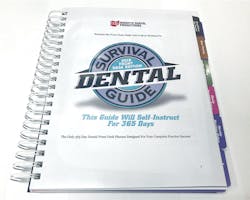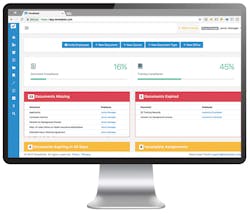The Dental Office Survival Guide: 2018 Front Desk Edition from Buckeye Dental Productions
The old adage about dental school is still as relevant as ever: dental school taught us to be dentists, not how to run a business. Unfortunately, it is tough to be the kind of dentist you want to be without being capable of running a business. The business stuff can be intimidating, so much more intimidating than the clinical challenges we face in our practices. I know this feeling intimately. I need help to survive on the Serengeti plain that is the business world. I need a guide. That is where The Dental Office Survival Guide: 2018 Front Desk Edition comes in.
Written by Missy Fryer and Mary Beth Bajornas, both dental front office superstars, TheDental Office Survival Guide is an organizational planning tool created to help guide front desk team members so they can accomplish all the tasks thrown at them throughout the day.
It all starts with operating your practice like a pilot flies an airplane—using checklists. Checklists help ensure nothing gets missed. This guide gives you all the checklists you need to run your practice.
The guide is broken up into many different sections. There is some basic training and information at the beginning of the guide. The real meat of the guide comes after that, starting with the Daily Marching Orders. This section is full of daily checklists for you and your team to start the day off on the right foot. Some parts of the checklists may sound obvious, such as turning on the lights. However, the point of using a checklist is to make sure no detail gets missed. Pilots do the same thing for every single flight. That is why planes don’t fall out of the sky. Checklists can save the day. Opening tasks, morning huddle, benefits verification—catching these details can make your day run more smoothly.
In addition to the daily checklists, there are weekly and quarterly checklists. And it doesn’t end there! There are monthly planning sections that help you structure and phase special holiday events, marketing specials, and practice goals. This guide truly helps pull you out of the day-to-day grind for a 30,000-foot view of your practice. That is something I have needed.
The Dental Office Survival Guide has helped me get my head wrapped around my practice and decide where to focus my team’s energy and efforts. Upon opening the guide, I was almost paralyzed by the amount of information and tools it contains. It took me about a month to break down and digest everything. We are slowly adding these checklists to our systems and getting ourselves organized. It will be a worthwhile process.
The Dental Office Survival Guide has been—and will continue to be—a great tool for us. Line-drive double to the power alley for Buckeye Dental Productions!
Silginat impression material by Kettenbach
When you ask patients what they dread about visiting us, there are a few tried and true responses. First up is obviously the injection. Beyond that, you will hear a variety of other things they don’t like. A very common response is impressions—patients don’t like impressions. They don’t like the feeling of gagging on a mouthful of goo for minutes at a time. They don’t like the taste of our materials. They don’t like much of anything when it comes to impressions. The day is coming when intraoral scanning and 3-D printing will be simple enough to end most impression procedures, but for now, we should do what we can to minimize the number of impressions we have to take and maximize their effectiveness. That is where Silginat, an impression material from Kettenbach, can help your practice.
Silginat is a polyvinyl siloxane (PVS) impression material formulated to put alginate out of its misery. Irreversible hydrocolloid materials, if you want to get technical about it, have served dentistry well; however, these materials have many weaknesses that might make you want to consider an alternative product such as Silginat.
Let’s talk about what alginate does wrong that Silginat does right. First, alginate mixing is technique sensitive. The water-to-powder ratio is important. Spatulation and timing are important as well. With Silginat, you get a consistent mixture every time with the automix tips.
Second, alginate impressions are time sensitive. They must be poured within a small window of time or else face dire consequences. Silginat does not have that issue. It can be stored. It can be sent to a lab to be poured. The time frame for pouring it is flexible.
Third, alginate can only be poured once. Better hope your assistant didn’t get a bubble in a critical spot on her pour. If she did, it could mean big trouble. Silginat can be repoured, which can save you from the embarrassment of having to call the patient to get another impression. These properties alone should have you considering switching to Silginat. Now let’s look at the logistics of a multiunit case that gets sent to your lab.
Your operative arch is where you are focused. You just did amazing preps and buildups. You packed two cords meticulously, caring for the soft tissue. You took a great impression of that arch with PVS impression material. You took an excellent bite registration with another PVS material. Now you are off to see another patient while your assistant gets an opposing impression with alginate. These separate pieces go to your lab to be mounted. Your lab has to mount a master impression, taken with PVS material, to an opposing cast, made from an alginate impression, using a PVS bite registration. You can see which of these parts is not like the others. Using alginate impressions to take opposing models for cases like this one could introduce an error in mounting, which would, at the very least, make the delivery of the case more difficult.
For all of these reasons, I strongly urge you to consider switching to an alginate replacement material. Silginat has worked great in my practice. We have even begun using it for our preoperative matrices for provisional fabrication. Patients seem to enjoy the reduced time and the strawberry flavor as well. They also love getting the impression right on the first try, which happens more often with Silginat than it does with alginate. Line-drive double into the gap for Kettenbach!
Done Desk human resources and risk management platform
My human resources skills can best be described as . . . lacking. I try my best. I think we all do. Despite our best intentions, collecting all of the correct information and documents and then storing and updating them is a massive burden. If Fortune 500 corporations ran their HR departments like most dentists do, they wouldn’t stay Fortune 500 for long. Remember though, every corporation has an entire department devoted to HR. We don’t—or at least we didn’t until now. Done Desk can be your corporate HR department.
Done Desk is a website designed to help meet your human resources and risk management needs. It is built just for dentistry, so it will fit your practice. This isn’t some corporate thingamajig shoehorned to work for dental practices. Done Desk was built and is maintained by Cary Smith of Dentist Secure, a dental-focused risk management firm and insurance brokerage. In essence, Done Desk is a dashboard for keeping track of all of your employees and their documentation that you need to keep on file.
Most of you are probably like me. You have the W-4s your employees filled out. You might have CVs or resumes too, if you can find them in your files. After that, the pickings are pretty slim. It’s not our fault—we were just never really trained on how to mitigate our risks with human resources. Done Desk helps.
Once you get signed up and logged on, you will be prompted to enter information for all of your team members. Done Desk will invite them to join via email. They will be prompted to enter their vital information, which Done Desk will store for you. Once all of your team members are registered, you’ll get a dashboard with all the information you need to collect: everything from an acknowledgment of receipt of practice policies to CPR certification to vaccination records. As you collect all of these documents for your team, the indicator bar showing your compliance will inch further and further toward completion. Getting started might be a chore because you probably did not have much of this information in your records previously. However, once you get this part completed, all you need to do is monitor tasks and onboard new team members as you hire them.
Don’t have a standard employee application or absence tracking form? Not to fret. Done Desk has you covered. With a library of more than 50 different forms and documents, Done Desk provides all the resources you need to reach compliance. I see document bundles like this sold for hundreds of dollars on their own. This is all included in your Done Desk membership.
In addition to document collection and storage, Done Desk offers vital training that our practices need. Your team can do their federal HIPAA and OSHA blood-borne pathogens training within Done Desk. As Done Desk develops, expect to see state-specific training programs added. I practice in Texas, where Done Desk is headquartered, so I have access to HB 300 training (Texas state-specific HIPAA training). I expect to see the state-specific training become more robust as time goes on.
Done Desk also helps with hiring team members. First, it ensures that you have prospective employees fill out the appropriate paperwork. Beyond that, Done Desk can run background checks on prospective team members for a nominal additional charge. All of this can be done directly from the Done Desk dashboard.
Despite all of this functionality, Done Desk is reasonably priced. Your subscription plan will depend on the number of employees you have, but the majority of practices will cost less than $100 per month. For ensuring that your bases are covered and your risk is mitigated, that seems like an amazing value proposition to me. Frozen-rope triple to the wall for Done Desk!
Joshua Austin, DDS, MAGD
About the Author
Joshua Austin, DDS, MAGD
Joshua Austin, DDS, MAGD, is a graduate and former faculty member of the University of Texas Health Science Center at San Antonio School of Dentistry. Author of Dental Economics’ Pearls for Your Practice column, Dr. Austin lectures nationally on products, dental technology, online reputation management, and social media. He maintains a full-time restorative dentistry private practice in San Antonio, Texas. You may contact Dr. Austin at [email protected].
Updated June 21, 2023






